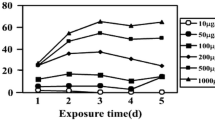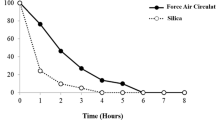Abstract
It has previously been shown that certain halophytes can grow and produce biomass despite of the contamination of their saline biotopes with toxic metals. This suggests that these plants are able to cope with both salinity and heavy metal constraints. NaCl is well tolerated by halophytes and apparently can modulate their responses to Cd. However, the underlying mechanisms remain unclear. This study explores the impact of NaCl on growth, Cd accumulation, and Cd speciation in tissues of the halophyte Sesuvium portulacastrum. Seedlings of S. portulacastrum were exposed during 1 month to 0, 25, and 50 μM Cd combined with low salinity (LS, 0.09 mM NaCl) or high salinity (HS, 200 mM NaCl) levels. Growth parameters and total tissue Cd concentrations were determined, in leaves, stems, and root. Moreover, Cd speciation in these organs was assessed by specific extraction procedures. Results showed that, at LS, Cd induced chlorosis and necrosis and drastically reduced plant growth. However, addition of 200 mM NaCl to Cd containing medium alleviated significantly Cd toxicity symptoms and restored plant growth. NaCl reduced the concentration of Cd in the shoots; nevertheless, due to maintenance of higher biomass under HS, the quantity of accumulated Cd was not modified. NaCl modified the chemical form of Cd in the tissues by increasing the proportion of Cd bound to pectates, proteins, and chloride suggesting that this change in speciation is involved in the positive impact of NaCl on Cd tolerance. We concluded that the tolerance of S. portulacastrum to Cd was enhanced by NaCl. This effect is rather governed by the modification of the speciation of the accumulated Cd than by the reduction of Cd absorption and translocation.


Similar content being viewed by others
References
Aldrich MV, Gardea-Torresdey JL, Peralta-Videa JR (2003) Uptake and reduction of Cr (VI) to Cr (III) by mesquite (Prosopis spp.): chromate–plant interaction in hydroponics and solid media studied using XAS. Environ Sci Technol 37:1859–1864
Arnon DI, Hoagland DR (1940) Crop production in artificial solutions and in soils with special reference to factors affecting yields and absorption of inorganic nutrients. Soil Sci 50:463–484
Barceló J, Poschenrieder C (1990) Plant water relations as affected by heavy metal stress: a review. J Plant Nutr 13:1–37
Ben Rejeb K, Ghnaya T, Zaier H, Benzarti M, Baioui R, Ghabriche R, Wali M, Lutts S, Abdelly C (2013) Evaluation of the Cd2+ phytoextraction potential in the xerohalophyte Salsola kali L. and the impact of EDTA on this process. Ecol Eng 60:309–315
Cappa JJ, Pilon-Smits EA (2014) Evolutionary aspects of elemental hyperaccumulation. Planta 239:267–275
Carrier P, Baryla A, Havaux M (2003) Cadmium distribution and microlocalization in oilseed rape (Brassica napus) after long-term growth on cadmium-contaminated soil. Planta 216:939–950
Castillo-Michel HA, Hernandez N, Martinez-Martinez A, Parsons JG, Peralta-Videa JR, Gardea-Torresdey JL (2009) Coordination and speciation of cadmium in corn seedlings and its effects on macro- and micronutrients uptake. Plant Physiol Biochem 47:608–614
Cosio C, DeSantis L, Frey B, Diallo S, Keller C (2005) Distribution of cadmium in leaves of Thlaspi caerulescens. J Exp Bot 412:765–775
Ghnaya T, Nouairi I, Slama I, Messedi D, Grignon C, Abdelly C, Ghorbel MH (2005) Cadmium effects on growth and mineral nutrition of two halophytes: Sesuvium portulacastrum and Mesembryanthemum crystallinum. J Plant Physiol 162:1133–1140
Ghnaya T, Slama I, Messedi D, Grignon C, Ghorbel MH, Abdelly C (2007a) Effects of Cd2+ on K+, Ca2+ and N uptake in two halophytes Sesuvium portulacastrum and Mesembryanthemum crystallinum: Consequences on growth. Chemosphere 67:72–79
Ghnaya T, Slama I, Messedi D, Grignon C, Ghorbel MH, Abdelly C (2007b) Cd-induced growth reduction in the halophyte Sesuvium portulacastrum is significantly improved by NaCl. J Plant Res 120:309–316
Ghnaya T, Zaier H, Baioui R, Sghaier S, Lucchini G, Sacchi GA, Lutts S, Abdelly C (2013) Implication of organic acids in the long-distance transport and the accumulation of lead in Sesuvium portulacastrum and Brassica juncea. Chemosphere 90:1449–1454
Han RM, Lefèvre I, Albacete A, Pérez-Alfocea F, Barba-Espín G, Díaz-Vivancos P, Quinet M, Ruan CJ, Hernández JA, Cantero-Navarro E, Lutts S (2012) Antioxidant enzyme activities and hormonal status in response to Cd stress in wetland halophyte Kosteletzkya virginica under saline conditions. Physiol Plant 147:352–368
Isaure MP, Fayard B, Sarret G, Pairis S, Bourguign J (2006) Localization and chemical forms of cadmium in plant samples by combining analytical electron microscopy and X-ray spectromicroscopy. Spectrochim Acta B 61:1242–1252
Jelonek MA, Wieczorek JF, Deckert J, Sobkowiak RR, Gzyl J, Sprada SP, Abramowski D, Jelonek T, Gwóźdź EA (2012) Nitric oxide implication in cadmium induced programmed cell death in roots and signaling response of yellow lupine plants. Plant Physiol Biochem 58:124–134
Komárek M, Tlustoš P, Száková J, Chrastny V (2007) The role of chloride salts in chemically enhanced phytoextraction of heavy metals from a contaminated agricultural soil. Bull Environ Contam Toxicol 78:176–180
Krantev A, Yordanova R, Janda T, Szalai G, Popova L (2008) Treatment with salicylic acid decreases the effect of cadmium on photosynthesis in maize plants. J Plant Physiol 165:920–931
Krzesłowska M (2011) The cell wall in plant cell response to trace metals: polysaccharide remodeling and its role in defense strategy. Acta Physiol Plant 33:35–51
Lokhande VH, Gor BK, Desai NS, Nikam TD, Suprasanna P (2013) Sesuvium portulacastrum, a plant for drought, salt stress, sand fixation, food and phytoremediation. A review. Agron Sustain Dev 33:329–348
López-Chuken UJ, Young SD (2005) Plant screening of halophyte species for cadmium phytoremediation. Z Naturforsch 60:236–243
Manousaki E, Kokkali F, Kalogerakis N (2009) Influence of salinity on lead and cadmium accumulation by the salt cedar (Tamarix smyrnensis Bunge). J Chem Technol Biotechnol 84:877–883
Martin SR, Llugany M, Barceló J, Poschenrieder C (2012) Cadmium exclusion a key factor in differential Cd-resistance in Thlaspi arvense ecotypes. Biol Plant 56:729–734
Mühlingh KH, Läuchli A (2003) Interaction of NaCl and Cd stress on compartmentation pattern of cations, antioxidant enzymes and proteins in leaves of two wheat genotypes differing in salt tolerance. Plant Soil 253:219–231
Ni TH, Wei YZ (2003) Subcellular distribution of cadmium in mining ecotype Sedum alfredii. Acta Bot Sin 45:925–928
Ozkutlu F, Ozturk L, Erdem H, McLaughlin M, Cakmak I (2007) Leaf-applied sodium chloride promotes cadmium accumulation in durum wheat grain. Plant Soil 290:323–331
Qiu Q, Wang Y, Yang Z, Yuan J (2011) Effects of phosphorus supplied in soil on subcellular distribution and chemical forms of cadmium in two Chinese flowering cabbage (Brassica parachinensis L.) cultivars differing in cadmium accumulation. Food Chem Toxicol 49:2260–2267
Reboreda R, Caçador I (2007) Halophyte vegetation influences in salt marsh retention capacity for heavy metals. Environ Pollut 146:147–154
Reboredo F (2012) Zinc compartmentation in Halimione portulacoides (L.) Aellen and some effects on leaf ultrastructure. Environ Sci Pollut Res 19:2644–2657
Salt DE, Prince RC, Pickering IJ, Raskin I (1995) Mechanisms of cadmium mobility and accumulation in Indian mustard. Plant Physiol 109:1427–1433
Sharma SS, Dietz KJ (2009) The relationship between metal toxicity and cellular redox imbalance: a review. Trends Plant Sci 14:43–50
Shevyakova NI, Netronina IA, Aronova EE, Kuznetsov VIV (2003) Compartmentation of cadmium and iron in Mesembryanthemum crystallinum plants during the adaptation to cadmium stress. Russ J Plant Physiol 179:57–64
Smýkalová I, Zámečníková B (2003) The relationship between salinity and cadmium stress in berlay. Biol Plant 46:269–273
Sousa AI, Caçador I, Lillebo AI, Pardal AM (2008) Heavy metal accumulation in Halimione portulacoides: intra- and extra-cellular metal binding sites. Chemosphere 70:850–857
Wang X, Liu Y, Zeng G, Chai L, Song X, Min Z, Xiao X (2008) Subcellular distribution and chemical forms of cadmium in Bechmeria nivea (L.) Gaud. Environ Exp Bot 62:389–395
Wójcik M, Vangronsveld J, D’Haen J, Tukiendorf (2005) A Cadmium tolerance in Thlaspi caerulescens II. Localization of cadmium in Thlaspi caerulescens. Environ Exp Bot 53:163–171
Wu FB, Dong J, Qian QQ, Zhang GP (2005) Subcellular distribution and chemical form of Cd and Cd–Zn interaction in different barley genotypes. Chemosphere 60:1437–1446
Zaier H, Mudarra A, Kutscher D, Fernández de la Campa MR, Abdelly C, Sanz-Medel A (2010) Induced lead binding phytochelatins in Brassica juncea and Sesuvium portulacastrum investigated by orthogonal chromatography inductively coupled plasma-mass spectrometry and matrix assisted laser desorption ionisation-time of flight mass spectrometry. Anal Chim Acta 671:48–54
Acknowledgments
This work was supported by the Tunisian Ministry of Higher Education and Scientific Research LR10CBBC02 and by the Spanish Government project BFU2010-14873.
Ethical statement
All authors of this manuscript declare and confirm that:
The manuscript has not been submitted to more than this journal (ESPR) for simultaneous consideration.
The manuscript has not been published previously.
A single study is not split up into several parts to increase the quantity of submissions and submitted to various journals or to one journal over time.
No data have been fabricated or manipulated.
No data, text, or theories by others are presented as if they were the author’s own.
We confirm that the manuscript has been read and approved by all named authors and that there are no other persons who satisfied the criteria for authorship but are not listed. We further confirm that the order of author listed in the manuscript has been approved by all of us.
The corresponding author is the sole contact for the editorial process. He is responsible for communicating with the other authors about progress of the publication.
Author information
Authors and Affiliations
Corresponding author
Additional information
Responsible editor: Elena Maestri
Electronic supplementary material
Below is the link to the electronic supplementary material.
ESM 1
(DOC 94 kb)
Rights and permissions
About this article
Cite this article
Wali, M., Fourati, E., Hmaeid, N. et al. NaCl alleviates Cd toxicity by changing its chemical forms of accumulation in the halophyte Sesuvium portulacastrum . Environ Sci Pollut Res 22, 10769–10777 (2015). https://doi.org/10.1007/s11356-015-4298-9
Received:
Accepted:
Published:
Issue Date:
DOI: https://doi.org/10.1007/s11356-015-4298-9




